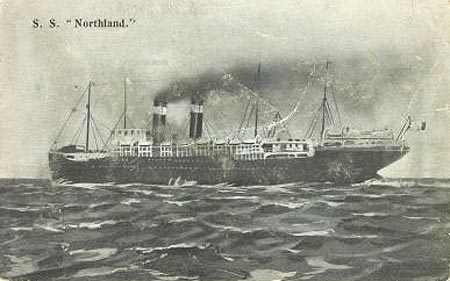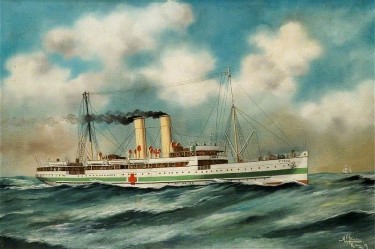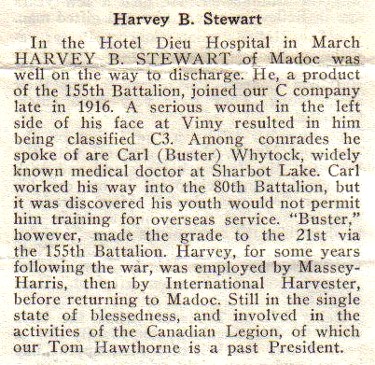|
Apr 11, 1892
|
Born in Madoc, Ontario to John Stafford and Mary
Anne “Minnie” (nee Burns) Stewart
|
|
Feb 21, 1916
|
Attested into the 155th Battalion in Madoc, Ontario
Ø Number 636658
Ø Next of kin given as John Stewart, father, Madoc, Ontario
Ø Previous occupation given as Salesman
o Later noted as Clerk
Ø No previous military experience given
Ø Religion given as Roman Catholic
The 21st Battalion trained in the Kingston, Ontario
area
|
|
Sep 4, 1916
|
Admitted to the Barriefield Military Hospital with a cold
|
|
Sep 5, 1916
|
Discharged to duty from hospital
|
|
Oct 17, 1916
|
Embarked the SS Northland in Halifax, Nova Scotia

|
|
Oct 28, 1916
|
Disembarked in Liverpool, England and the
battalion proceeded to Bramshott
|
|
Dec 5, 1916
|
Transferred to the 21st Battalion
|
|
Dec 6, 1916
|
Arrived at the CBD (Canadian Base Depot) in the
Rouelles Camp, Havre, France as part of a draft of 147 reinforcements from
England and TOS (Taken On Strength) the 21st Battalion
Admitted to the No. 39 General Hospital in Havre
with a diagnosis that reads VDG (Venereal Disease Gonorrhea)
|
|
Dec 31, 1916
|
Discharged from hospital and reported to the base
depot in Havre to receive out patient treatment
|
|
Feb 19, 1917
|
After leaving the base depot, he joined the 2nd
Canadian Entrenching Battalion in Hersin, France
|
|
Feb 26, 1917
|
After leaving the entrenching battalion, Private
Stewart finally joined the 21st Battalion at the front in the Elbe
Trench, east of Neuville Saint Vaast and was posted to “C” Company
|
|
Mar 15, 1917
|
While on a work party, Private Stewart suffered
the effects of gas poisoning and was evacuated to a nearby field ambulance
for first aid
|
|
Mar 17, 1917
|
Transferred to the No. 6 CCS (Casualty Clearing
Station) for treatment. He was later
released and rejoined the 21st Battalion. The effects of this exposure would
resurface later as will be seen
|
|
Apr 9, 1917
|
During the capture of Vimy Ridge, Private Stewart
received a shrapnel wound to his left eye.
He was evacuated to a nearby field ambulance for first aid, then
transferred to a casualty clearing station
|
|
Apr 11, 1917
|
Transferred to the No. 13 Stationary Hospital in
Boulogne
|
|
Apr 14, 1917
|
Invalided to England aboard the Hospital Ship St.
Denis

On arrival in England, he was admitted to the
King George Hospital, Stamford St., London
Transferred to the EORD (Eastern Ontario
Regimental Depot) for pay purposes while in hospital
|
|
May 9, 1917
|
Transferred to the Westcliffe Eye and Ear
Hospital in Folkestone to be treated for vision problems. On admission he was noted as being shaky
and nervous, as well as sleeping poorly.
He was then employed in the hospital’s Officer’s
Mess and as a Batman to give him time to recover while performing light
duties.
|
|
Oct 2, 1917
|
Discharged from hospital with 10 days sick leave and a
recommendation for 6 months of light duties
|
|
Oct 14, 1917
|
Joined the Eastern Ontario Regimental Depot in
Seaford from leave
|
|
Oct 23, 1917
|
Attached to the 6th Reserve Battalion
in Seaford
|
|
Nov 28, 1917
|
Medical Board notes
Ø Suffers from defective vision
due to Retinitis caused by shell explosion April 9, 1917
Ø Impaired vision will not be improved
with glasses
Ø Vision will likely improve
with time
|
|
Feb 4, 1918
|
Admitted to the No. 14 Canadian General Hospital
in Eastbourne with a diagnosis that reads Laryngitis and Syphilis
Ceased to be attached to the 6th
Reserve Battalion on admission to hospital
On admission he could only speak in a whisper due
to gas poisoning at the front
|
|
Feb 22, 1918
|
Discharged to receive out patient treatment for
his Syphilis
|
|
Mar 4, 1918
|
Transferred to the Canadian Military Hospital,
Etchinghill, Lyminge
|
|
Apr 12, 1918
|
Circumcision performed to correct damage from the
Syphilis infection
|
|
May 15, 1918
|
Transferred to the Westcliffe Canadian Eye and
Ear Hospital and Aphonia (inability to speak) was added to the diagnosis
|
|
Jul 25, 1918
|
Medical Board notes
Ø Examination shows vocal cords
reddened and roughed
Ø It will be months before he
will be able to speak above a whisper
Ø Board recommends he be
invalided to Canada for discharge
|
|
Oct 1, 1918
|
Transferred to the No. 5 Canadian General
Hospital in Kirkdale, Liverpool
|
|
Oct 14, 1918
|
Invalided to Canada aboard the Hospital Ship
Araguaya

|
|
Oct 27, 1918
|
Disembarked in Halifax, Nova Scotia and proceeded
to Kingston, Ontario where he was TOS (Taken On Strength) Military District
No. 3 Depot and admitted to the Queen’s Military Hospital
|
|
Oct 30, 1918
|
Granted leave until November 14, 1918
|
|
Nov 15, 1918
|
Granted leave until November 18, 1918
|
|
Nov 22, 1918
|
Granted leave until December 2, 1918
|
|
Dec 10, 1918
|
Medical Board notes
Ø Suffers from Chronic Laryngitis
with partial Aphonia caused by gas exposure at the front
Ø Cannot speak above a whisper
Ø Man appears well nourished and
otherwise healthy
Ø There is a cyst on upper
eyelid of right eye but patient does not wish surgery for removal
Ø Board recommends he be
discharged from service with pensionable disability due to his service at the
front
|
|
Dec 16, 1918
|
Discharged to duty from hospital and posted to
the Casualty Company in Kingston
|
|
Dec 17, 1918
|
Medical Board notes
Ø Man suffers from Chronic Laryngitis
with partial Aphonia
Ø Was gassed in March of 1917
and lost his voice for 6 months
Ø Can only speak in a low voice
and cannot shout
Ø There is a cyst over right
upper eyelid but refuses surgery to remove it
|
|
Dec 21, 1918
|
Discharged from the CEF in Kingston, Ontario
Ø Rank on discharge
Ø Entitled to War Service Badge
Class “A” and War Service Badge Class “B”
Ø Proposed residence on
discharge, Madoc, Ontario
Following his discharge, the British War Medal
and Victory Medals were sent to him at Madoc, Ontario
From the 1960 summer issue of the Communiqué, the post war newsletter of
the 21st Battalion Association

|
| Feb 7, 1971 |
Harvey Burns Stewart died and was buried in the Sacred Heart of Mary Cemetery, Old Location, Madoc, Ontario
|

